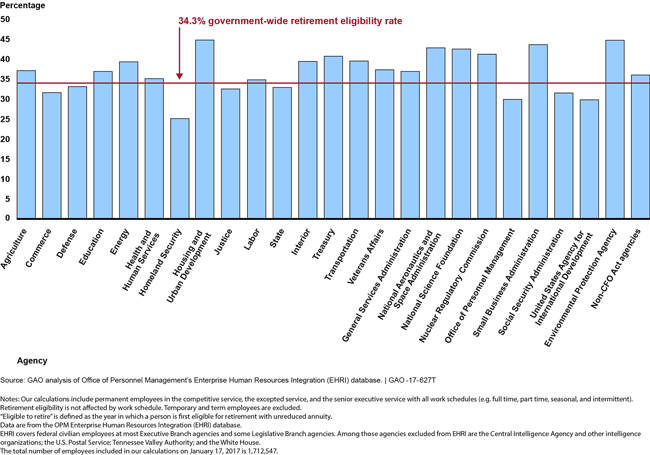Federal Workforce: Sustained Attention to Human Capital Leading Practices Can Help Improve Agency Performance
Fast Facts
As shown below, many federal employees are eligible to retire. As they do, agencies need to hire people with the right skills—not just replace those who leave. To recruit and retain a skilled workforce, the federal pay system may need to be reexamined.
In this testimony, we discussed strategies high-performing organizations use to design pay systems, such as ensuring pay decisions are transparent.
We also talked about existing management tools agencies can use to close skills gaps, including adopting human capital management best practices and strengthening human resource offices.
Percentage of Federal Employees On Board by the End of Fiscal Year 2015 Eligible to Retire by Fiscal Year 2020

Bar graph showing percentage of federal employees eligible to retire by 2020, by agency.
Highlights
What GAO Found
GAO's prior work has shown that implementing a market-based and more performance-oriented federal pay system is both doable and desirable, and should be part of a broader strategy of change management and performance improvement initiatives. In 2005, GAO identified the following key themes that highlight the leadership and management strategies high-performing organizations collectively considered in designing and managing a pay system that is performance oriented, affordable, and sustainable. Specifically, they:
1. Focus on a set of values and objectives to guide the pay system.
2. Examine the value of employees' total compensation to remain competitive in the labor market.
3. Build in safeguards to enhance the transparency and ensure the fairness of pay decisions.
4. Devolve decision-making on pay to appropriate levels.
5. Provide clear and consistent communication so that employees at all levels can understand how compensation reforms are implemented.
6. Build consensus to gain ownership and acceptance for pay reforms.
7. Monitor and refine the implementation of the pay system.
While the federal compensation system may need to be re-examined, Congress has already provided agencies with tools and flexibilities to build and maintain a high-performing workforce. They include, for example:
Hiring process
GAO reported in 2016 that the Office of Personnel Management (OPM) and selected agencies had not evaluated the effectiveness of hiring authorities. By evaluating them, of which over 100 were used in 2014, OPM and agencies could identify ways to expand access to those found to be more effective, and eliminate those found to be less effective.
General Schedule (GS) classification system
The federal government has become more highly skilled and specialized than the GS classification system was designed to address at its inception in 1949. OPM and stakeholders should examine ways to make the classification system consistent with attributes GAO identified of a modern, effective classification system, such as internal and external equity.
Performance management
Credible and effective performance management systems are a strategic tool to achieve organizational results. These systems should emphasize “a line a sight” between individual performance and organizational success, and use core competencies to reinforce organizational objectives, among other things.
Human resources capacity
The human resources specialist occupation is a mission critical skills gap area. Chief Human Capital Officers have reported that human resources specialists do not have the skills to lead strategic human capital management activities. Strengthening this capacity could help agencies better meet their missions.
Why GAO Did This Study
A careful consideration of federal pay is an essential part of fiscal stewardship and is necessary to support the recruitment and retention of a talented, agile, and high-performing federal workforce. High-performing organizations have found that the life-cycle of human capital management activities—including workforce planning, recruitment, on-boarding, compensation, engagement, succession planning, and retirement programs—need to be aligned for the cost-effective achievement of an organization's mission. However, despite some improvements, strategic human capital management—and more specifically, skills gaps in mission critical occupations—continues to be a GAO high-risk area.
This testimony is based on a body of GAO work primarily issued between June 2012 and March 2017. It focuses on (1) lessons learned in creating a more market driven, results-oriented approach to federal pay, and (2) opportunities, in addition to pay and benefits, that OPM and agencies could use to be more competitive in the labor market and address skills gaps.
Recommendations
Over the years, GAO has made recommendations to agencies and OPM to improve their strategic human capital management efforts. OPM and agencies generally concurred. This testimony discusses actions taken to implement key recommendations to improve federal hiring and classification.
